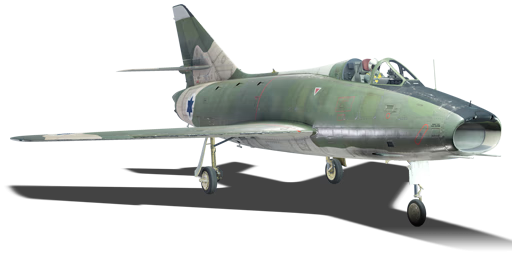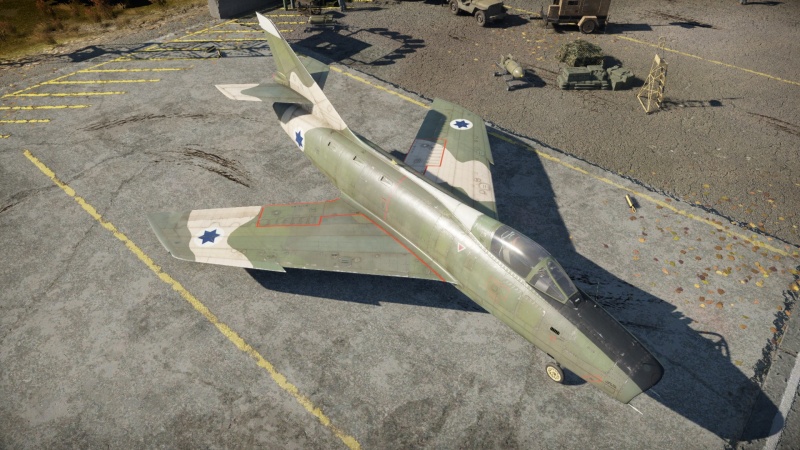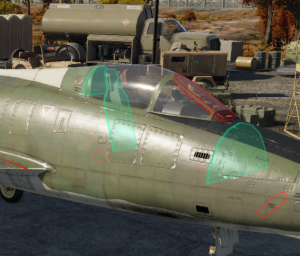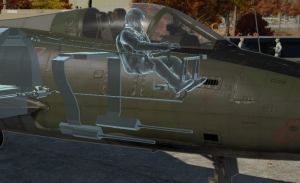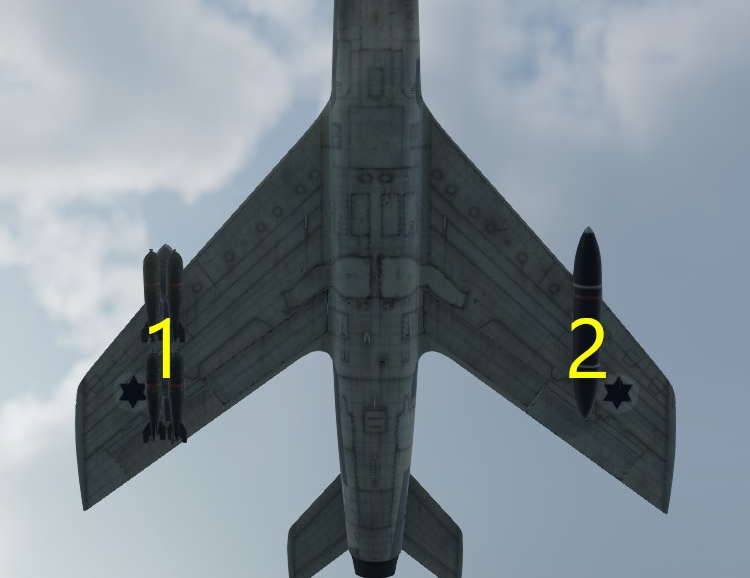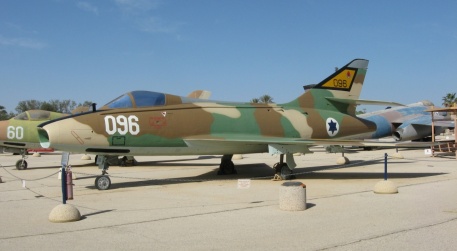Sambad
Contents
Description
During the 1956 Suez Crisis, Israel realised a need for a new, long-range, high-endurance jet fighter. Thus, with close ties to France, they placed an order for 24 Super Mystere B2s (called Sambad in Israel) in 1958. These planes were involved in the Six-Day War in which it saw extensive use. The aircraft were also involved in the USS Liberty incident where 2 Sambads released their napalm bombs on the USS Liberty. The Sambad also saw use in the Yom Kippur War in 1973, during which 6 were shot down. It served well as the first supersonic fighter in IAF service.
The Sambad was introduced in Update "Winged Lions". It plays similarly to a delta wing fighter, capable of pulling extreme manoeuvres while it has enough speed. The acceleration and cruise speed of the plane at low and medium altitudes is mediocre compared to similar BR fighters. This, alongside the awful low-speed manoeuvrability and bad energy retention makes this plane best used as a support fighter. It can use the afterburner to climb to high altitudes or stay fast in the outskirts of the fight, picking slow moving enemies with its excellent guns or the Shafrir missiles. Pilots should stay fast, do wide turns to avoid losing energy and help the team in different ways, picking up enemies that are closing in allies and destroying damaged targets that are fleeing the battlefield.
General info
Flight performance
The Sambad flies in a similar manner to the preceding Mystere IVA, with excellent AOA at low airspeeds, behaving similarly to later delta-winged designs. This allows it to shed off energy and allow pilots to force aircraft that are on their tail to overshoot; however, this can allow the Sambad to be easily trapped in a low energy state, and the poor acceleration will not be able to save the pilot. Unlike the Mystere, the Sambad compresses at higher airspeeds (usually above 900 km/h), restricting it to around 8-10 Gs of pull. This allows the Sambad to maintain energy and maintain higher airspeeds, and pilots are advised to use this to their advantage. This can make up for the lacklustre acceleration at the lower end of performance, allowing pilots to bleed the speed of opposing aircraft whilst keeping their own speed high. The roll rate is average, better than the MiG-17 but below that of the Sabres, and pilots should be able to evade shots easily in most cases.
| Characteristics | Max Speed (km/h at 0 m - sea level) |
Max altitude (metres) |
Turn time (seconds) |
Rate of climb (metres/second) |
Take-off run (metres) | |||
|---|---|---|---|---|---|---|---|---|
| AB | RB | AB | RB | AB | RB | |||
| Stock | 1,176 | 1,143 | 17000 | 31.8 | 33.1 | 47.5 | 47.5 | 800 |
| Upgraded | 1,208 | 1,199 | 30.4 | 31.0 | 76.0 | 61.0 | ||
Details
| Features | |||||
|---|---|---|---|---|---|
| Combat flaps | Take-off flaps | Landing flaps | Air brakes | Arrestor gear | Drogue chute |
| ✓ | ✓ | ✓ | ✓ | X | ✓ |
| Limits | ||||||
|---|---|---|---|---|---|---|
| Wings (km/h) | Gear (km/h) | Flaps (km/h) | Max Static G | |||
| Combat | Take-off | Landing | + | - | ||
| 1,265 | 447 | 620 | 589 | 435 | ~10 | ~4 |
| Optimal velocities (km/h) | |||
|---|---|---|---|
| Ailerons | Rudder | Elevators | Radiator |
| < 600 | < 610 | < 590 | N/A |
Engine performance
| Engine | Aircraft mass | ||||||
|---|---|---|---|---|---|---|---|
| Engine name | Number | Empty mass | Wing loading (full fuel) | ||||
| SNECMA Atar 101G2 | 1 | 7,105 kg | 262 kg/m2 | ||||
| Engine characteristics | Mass with fuel (no weapons load) | Max Takeoff Weight | |||||
| Weight (each) | Type | 11m fuel | 20m fuel | 30m fuel | 38m fuel | ||
| 950 kg | Afterburning axial-flow turbojet | 7,711 kg | 8,192 kg | 8,726 kg | 9,154 kg | 11,645 kg | |
| Maximum engine thrust @ 0 m (RB/SB) | Thrust to weight ratio @ 0 m (WEP) | ||||||
| Condition | 100% | WEP | 11m fuel | 20m fuel | 30m fuel | 38m fuel | MTOW |
| Stationary | 3,003 kgf | 4,144 kgf | 0.54 | 0.51 | 0.47 | 0.45 | 0.36 |
| Optimal | 3,222 kgf (600 km/h) |
4,535 kgf (600 km/h) |
0.59 | 0.55 | 0.52 | 0.50 | 0.39 |
Survivability and armour
The Sambad is protected by several layers of steel and bulletproof glass, both in front and behind the pilot. The front windshield is a 40 mm bulletproof glass pane, angled at 61°, this is enough to stop rifle-calibre rounds and massively reduce the velocity of heavy machine guns such as the .50 cal M3 Browning. This will provide partial protection in head-on attacks, however pilots should not rely on this to protect the pilot as concentrated fire will overwhelm it. The pilot is also protected by three 14 mm sheets of armour, two behind and one slightly ahead of the windshield. The fuel tanks are all self-sealing, and take the space directly ahead of the engine and most of the wing between the spars.
Modifications and economy
As the Sambad is an Air Supremacy fighter, performance and air-to-air missiles should be the pilot's top priority. Compressor should be the first modification chosen, as the acceleration for a non-upgraded plane is subpar for the rank. It is also recommended to research the Matra Type 61 modification, as it is needed to gain access to the Shafrir air-to-air missile at tier IV. Next, it is recommended to research New boosters and the Matra Type 116 rocket modification. The Sambad feels slightly sluggish without boosters and compresses at high speed, boosters help to correct that. At tier III, Wings repair and Engine are next recommended; this will decrease the drag of the wings and increase the engine's thrust, greatly helping performance. Once these two modifications are unlocked, pilots can then research the Shafrir missile, allowing its use against faster or unaware aircraft. At this stage the pilot can then research Cover, G-suit, Airframe, and Fuselage repair. This will grant the full performance of the aircraft, and the pilot can then research the other modifications, namely Offensive 30 mm, New 30 mm cannons, and the 100, 250 and 500 kg bomb modifications.
Armaments
Offensive armament
The Sambad is armed with:
- 2 x 30 mm DEFA 552 cannons, chin-mounted (150 rpg = 300 total)
The Sambad is equipped with 2 x DEFA 552 30 mm cannons mounted on the underside of the nose; 150 rounds per gun giving a trigger time of 7.5 seconds. The DEFAs will be familiar to Israeli pilots, as every rank 6 Israeli jet uses the 30 mm DEFA. The cannons have good fire rate, great damage but a relatively low muzzle velocity at 810 m/s. Pilots should expect to require plenty of lead, but the good damage and great ammo capacity for a cannon will serve well once well practiced.
Suspended armament
The Sambad can be outfitted with the following ordnance:
| 1 | 2 | ||
|---|---|---|---|
| 100/50 kg G.P. bombs | 4 | 4 | |
| 250/50 kg G.P. bombs | 1 | 1 | |
| 500/50 kg G.P. bombs | 1 | 1 | |
| Mk.2 incendiary bombs | 1 | 1 | |
| SNEB type 23 rockets | 19 | 19 | |
| T10 151 rockets | 6 | 6 | |
| Shafrir missiles | 1 | 1 | |
| Maximum permissible weight imbalance: 450 kg | |||
| Default weapon presets | |
|---|---|
| |
Usage in battles
The Sambad is best used as a support fighter, using its high speed energy retention and relatively high top speed for the rank to its advantage. Pilots can use this to attack enemies which are slow or distracted, making slashing attacks and quickly escaping. The use of vertical manoeuvres is also recommended, as the Sambad will maintain a high rate of climb while in the high speed state, allowing the pilot to drain the speed of slower aircraft. if necessary a spiral can also be added to the climb, this is the most effective way to deal with higher ranking Delta-wing designs like the Draken, as they will bleed prodigious amounts of energy while attempting to follow, eventually stalling and allowing the Sambad pilot to drop on the slow opponent. Pilots should note however, that this applies when the Sambad is at high speed, as the energy retention at slower speeds falls off significantly. If the Sambad is caught at a low energy state, it is recommended to force an overshoot, using the excessive energy loss as a benefit. Pilots can then use their cannons, or the Shafrir air-to-air missile to attempt to kill the enemy aircraft as it flies away, and begin to regain speed. It is recommended to avoid this whenever possible, as the plane is best used at high speed. In ground battles, staying low and fast is recommended as the Sambad lacks CCIP, requiring the pilot to close the distance for accurate fire of its bombs and rockets. The Sa'ar which falls behind the Sambad in the tree should be preferred for CAS missions.
Pros and cons
Pros:
- Powerful gun armament will have no trouble destroying other planes
- Good variety of payload options
- Has access to a pair of Shafrir AAMs
- Equipped with a drogue chute to aid with braking during landings
- Better high-speed acceleration than a lot of its contemporaries thanks to its afterburner
Cons:
- Not very good vertical energy retention
- Bad stock performance
- Mediocre low-speed acceleration, even with the afterburner
- Can face faster opponents when uptiered
History
The Super Mystere B2 Sambad was operated by the IAF after an order for 24 aircraft was placed in 1958. Operated mainly as a single seat bomber, it was the IAF's first supersonic afterburning fighter and was used as its first-line plane from 1958-1962. The plane first entered service with the 105 Squadron at Hazor AFB. Some encounters during small border skirmishes between the MiG-17 and the Sambad occurred in the late 1950s to early 1960s with no clear superior fighter at the end.
At the start of the Six-Day War, Israel operated even more Mysteres thanks to an extra batch of ex-Armee de l'Air units joining the 105 squadron, that had 39 total aircraft at the start of the war. During the first day, Israeli Sambads were tasked with different missions. They were used to attack enemy airfields and also participated in interception missions against enemy bombers. During the first day of the war, 105 squadron flew 128 sorties, encountered and shot down a pair of Syrian MiG-21s for a total of 5 air kills and several aircraft destroyed on the ground during raids against enemy airfields.
After these operations, the focus of the Sambads was placed to help Israeli ground forces in the attack. The Sambads were used to attack enemy armour, destroying tanks, artillery pieces and fortifications and disrupting enemy logistics in different fronts and also helping to provide air cover and ground support during airborne operations. A pair of Super Mysteres were part of the USS Liberty Incident, in which 2 Super Mysteres armed with napalm bombs released their ordnance on an American ship mistaken by Israeli intelligence as an Egyptian ship. 105 squadron flew a total of 507 sorties during the war and lost 9 aircraft with 6 pilots killed and another taken captive.
After the French arms embargo against Israel, and the identification of lacking engine performance in the aircraft, 26 Sambads were converted to the Sa'ar in 1973, a version of the Super Mystere B2 fitted with the same engine used in the IAF's A-4 Skyhawks, the Pratt & Whitney J52-P-8A. The Sambad would be taken out of service in 1976.
Media
- Skins
See also
- Related development
External links
Paste links to sources and external resources, such as:
- IAF Aircraft Inventory: Dassault Super Mystere
- IAF - Dassault Super-Mystere B2 (Hebrew nickname: 'Sambad')
| Dassault Aviation | |
|---|---|
| WW2* | |
| Fighters | M.B.152C1 · M.B.157 |
| Bombers | M.B.162 · M.B.174A-3 · M.B.175T |
| Jet Aircraft | |
| M.D 450 | M.D.450B Barougan · M.D.450B Ouragan |
| Mystère | M.D.452 IIA · M.D.452 IIC · Mystere IVA |
| Super Mystère | Super Mystere B2 |
| Étendard | Etendard IVM |
| Super Étendard | Super Etendard |
| Alpha Jet | Alpha Jet E** |
| Mirage | |
| Mirage III | Mirage IIIC · Mirage IIIE · Milan |
| Mirage V | Mirage 5F |
| Mirage F1 | Mirage F1C · Mirage F1C-200 · Mirage F1CT |
| Mirage 2000 | Mirage 2000-5F · Mirage 2000C-S4 · Mirage 2000C-S5 · Mirage 2000D-R1 · Mirage 2000D-RMV |
| Mirage 4000 | Mirage 4000 |
| Export | |
| M.D 450 | M.D.450B Ouragan |
| Mystere | Mystere IVA |
| Super Mystère | Sambad · Sa'ar*** |
| Mirage | Shahak · ▄Mirage 5BA · ␗Mirage 2000-5Ei |
| *The company was named "Société des Avions Marcel Bloch" before being renamed in 1947 | |
| **Jointly manufactured with Dornier Flugzeugwerke | |
| ***Israeli Super Mystère refitted with new avionics and an American engine | |
| See also | SABCA |
| Israel jet aircraft | |
|---|---|
| Kfir Canard · Kfir C.2 · Kfir C.7 · Nesher | |
| Britain | |
| Meteor | Meteor NF.13 · Meteor F.8 |
| France | |
| Vautour | Vautour IIA · Vautour IIN |
| Super Mystere | Sambad · Sa'ar |
| Mirage III | Shahak |
| Other | M.D.450B Ouragan · Mystere IVA |
| USA | |
| F-84 | F-84F |
| A-4 | A-4H · A-4E Early (M) · A-4E · Ayit |
| F-4 | Kurnass · Kurnass 2000 |
| F-15 | Baz · Baz Meshupar · F-15I Ra’am |
| F-16 | Netz · F-16C Barak II · F-16D Barak II |


